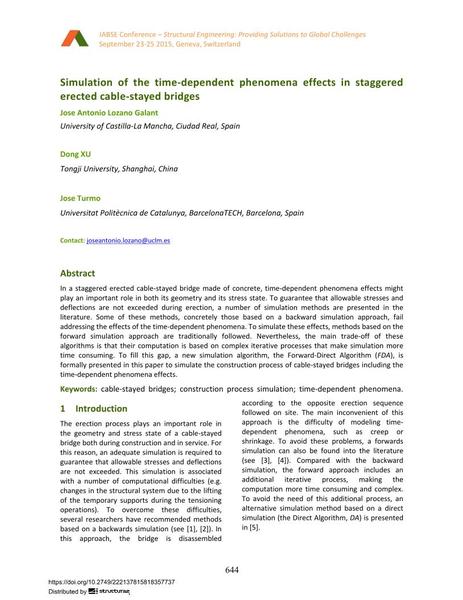Simulation of the time-dependent phenomena effects in staggered erected cable-stayed bridges

|
|
|||||||||||
Bibliografische Angaben
| Autor(en): |
Jose Antonio Lozano Galant
(University of Castilla-La Mancha, Ciudad Real, Spain)
Xu Dong (Tongji University, Shanghai, China) José Turmo |
||||
|---|---|---|---|---|---|
| Medium: | Tagungsbeitrag | ||||
| Sprache(n): | Englisch | ||||
| Tagung: | IABSE Conference: Structural Engineering: Providing Solutions to Global Challenges, Geneva, Switzerland, September 2015 | ||||
| Veröffentlicht in: | IABSE Conference Geneva 2015 | ||||
|
|||||
| Seite(n): | 644-650 | ||||
| Anzahl der Seiten (im PDF): | 7 | ||||
| Jahr: | 2015 | ||||
| DOI: | 10.2749/222137815818357737 | ||||
| Abstrakt: |
In a staggered erected cable-stayed bridge made of concrete, time-dependent phenomena effects might play an important role in both its geometry and its stress state. To guarantee that allowable stresses and deflections are not exceeded during erection, a number of simulation methods are presented in the literature. Some of these methods, concretely those based on a backward simulation approach, fail addressing the effects of the time-dependent phenomena. To simulate these effects, methods based on the forward simulation approach are traditionally followed. Nevertheless, the main trade-off of these algorithms is that their computation is based on complex iterative processes that make simulation more time consuming. To fill this gap, a new simulation algorithm, the Forward-Direct Algorithm (FDA), is formally presented in this paper to simulate the construction process of cable-stayed bridges including the time-dependent phenomena effects. |
||||
| Stichwörter: |
Schrägseilbrücken
|
||||

